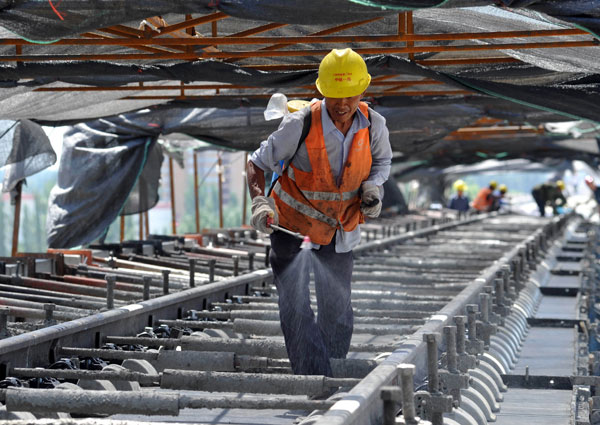Challenging times on 'high-speed Silk Road'
Updated: 2013-07-12 07:38
By Cui Jia (China Daily)
|
||||||||
Workers on new 1,776-km rail link no strangers to tough conditions, reports Cui Jia in Urumqi.
It was just after midnight in Hami prefecture in the Xinjiang Uygur autonomous region and the construction workers on the Lanzhou-Urumqi high-speed railway had just started work.
 |
|
Work proceeds on the Lanzhou-Urumqi high-speed railway, the longest such rail link under construction in the world. Yao Tong / for China Daily |
The men work at night to avoid the intense heat of the day that causes the water in the concrete mix to evaporate too quickly and could compromise the strength of the bridge being built, making it too fragile to meet stringent safety and engineering standards.
The stifling summer heat is just one of the challenges facing the 30,000 workers on the Xinjiang section of the project.
The 1,776-km-long railway, which on completion will link the capitals of Gansu province and Xinjiang, crosses the desolate and inhospitable Qinghai-Tibet Plateau, the arid sands of the Gobi Desert and a number of high-wind areas. These features make construction of the rail link a difficult and risky task.
The project, dubbed the "high-speed Silk Road", is the longest high-speed railway under construction in the world and the first in China to be built partly across a plateau.
After five years' work in Gansu, Xinjiang and Qinghai province, the line is scheduled to be operational by the end of 2014. The team in Xinjiang expects to finish laying the tracks by November.
Currently, only one railway carries passengers and cargo in and out of Xinjiang, the old Lanzhou-Urumqi railway, which connects Xinjiang with the rest of China and also provides a link to Central Asia and Europe.
The new line follows hot on the heels of the 11,179-km Chongqing-Xinjiang-Europe International Railway, which officially came into service in 2012. The C-X-E starts in Chongqing, crosses the Alataw Pass, on the border with Kazakhstan, via the old Lanzhou-Urumqi railway, and then progresses through Russia, Belarus and Poland before terminating at Duisburg, Germany. The journey takes an average of 16 days, roughly three weeks faster than the ocean route from China's eastern provinces.
Most Viewed
Editor's Picks

|

|

|

|

|

|
Today's Top News
Saudi princess charged with US human trafficking
Asiana takes out apology ad in Chinese media
Asia spending too little on poor: report
Constructive mood at Sino-US talks
China, Russia consider increasing naval drills
No mechanical trouble on Asiana
More Americans favor immigration
Increased cooperation brings benefits
US Weekly

|

|














